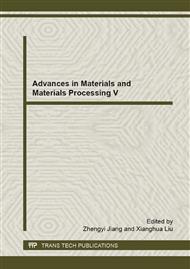p.894
p.898
p.902
p.906
p.911
p.915
p.922
p.927
p.934
Study on the Microstructure of Thermoforming
Abstract:
Thermoforming is a typical process to manufacture ultra-high strength steel sheet in auto industry. 22 MnB5 type is the widely used sheet. This paper uses thermal coupler software Pam-stamp 2011 to simulate the thermoforming of 22 MnB5 steel sheets. Get the temperature field distribution of thermoforming parts and martensite content. In addition, it discusses the thermal forming experiment process. Test the contents of thermoforming parts such as tensile strength, vickers hardness and so on. The experimental results show that in the components of this experiment, the hardness of the side wall is higher than other places. In the analysis of the microstructure, we can see that the thermal forming components are of martensite structure. Seen from the results of the simulation, they are consistent with the data from the experiment.
Info:
Periodical:
Pages:
911-914
Citation:
Online since:
March 2015
Authors:
Price:
Сopyright:
© 2015 Trans Tech Publications Ltd. All Rights Reserved
Share:
Citation:


